Festivulve Celebrates the Diversity of the Vulva
The First Edition of the Francophone Festival Wrapped Up June 10
It was all about the vulva, in quite literally any shape, form, or colour at the first edition of Festivulve.
We agreed that we’d never seen so much vulva themed artwork gathered under one roof before. Anywhere the eye turned to over the weekend… vulva! Vulva! VULVA!
There was an extensive range of artwork dedicated to its celebration, like knitted pieces, paintings, a tattoo artist, sex toys, and sex education resources.
The festival featured a wide range of programming, from a conference on how to find the G-spot, burlesque performances, to a workshop on sculpting clay vulvas.
The founder of Festivulve, Mel Goyer, said that 1000 tickets were sold in advance, and estimated that around 2000 people attended over the weekend.
Vulva Day One – June 9
I arrived at the Festivulve on its first day a little after 10 a.m. Already, the event was well underway. Tempting coffee aromas enveloped me as I entered the Loft Hotel, a techno beat played as we made our way inside. Americano in hand, I walked through a narrow hallway and landed on an island of vulvas.
The room was tightly packed with displays, artists and volunteers who were already deep in conversation with festival-goers.
Artist Brie Birdsell From Vulvaluv
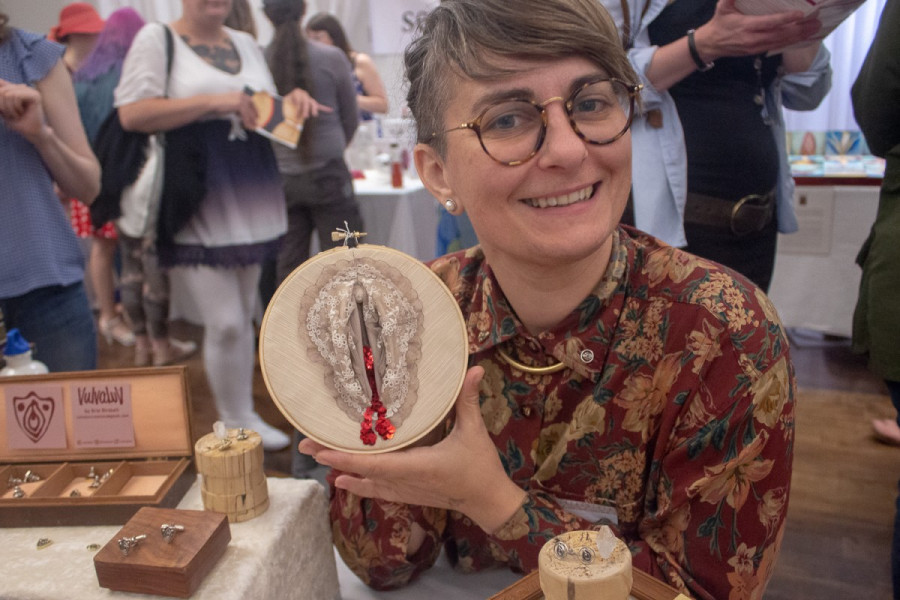
Brie Birdsell, an artist tabling at Festivulve, has been making vulva art since she was a teenager but started the Vulvaluv business two years ago. The necklaces and earrings adorned by a vulva crest, a symbol of protection against the patriarchy, have been popular.
“It’s really great that [Goyer] put so much of herself and her energy into making this space for us to celebrate,” said Birdsell. “And it’s great to see how many people are out for the festival.”
Birdsell’s vulva portraits caught my attention. Using a simple embroidery hoop and reclaimed fabric, she creates art that celebrates the vulva diversity by showcasing different sizes, shapes, colours and textures.
“I do this because of how much shame is being put onto that part of the body,” explained Birdsell, “how we’re made to feel like it’s gross, or you know, it needs to be cleaned or hidden, or look a certain way.”
Goyer brought Festivulve to life for the same reason. She shared that the concept of the event is the celebration of the natural diversity and beauty of vulvas.
Goyer explained, in French, that the idea was for the festival to be accessible to all and for everyone to have fun, and for women to reclaim their power through education.
Festivulve certainly was a space for discovery, pleasure, and learning. Many attendees diligently took notes during the conferences.
Conference “Ces Poils Autour”
I attended my first presentation of the day at 11:15 a.m. The speaker, Marie-Andrée Boivin, explained the relationship between the patriarchal system and the removal of hair on women’s bodies.
“It’s a process,” said attendee Gabby Otis about accepting one’s body hair, after Boivin’s talk. “It’s good to hear someone else saying it, see that it’s normal, and that other people think the same way.”
For women to learn to accept their body is what Goyer hopes attendees will get from Festivulve. She added that she is over the “Barbie” version of the vulva: pink, hairless, and scented.
Sculptor Jessica Sallay-Carrington
On June 9, I also met Jessica Sallay-Carrington, a ceramic sculptural artist who was selling vulva mugs. The mugs are part of a series she started with the hope of helping people being comfortable with their own bodies, and spreading the message that there is nothing to be ashamed of.
“It’s a fun series to see how many different kinds of vulvas there are, and how different they all look,” said Sallay-Carrington. She sculpts from photos; her diverse series comprise the vulvas of her cis and trans friends.
The sculptor shared that one of her clients said that getting her vulva sculpted was a form of self-love, a way of saying that her bits are beautiful and that she is proud of them.
Vulva Day Two – June 10
On the second day of Festivulve, every room rented was filled with people. A rectangular table in one corner displayed clay sculptures of any sort of vulva imaginable, from the fantastical and toothed, to the anatomically correct and hairy.
They were the product of a morning workshop, hosted by Myriam Fougère. After leaving the festival two hours later, I saw a man carrying a sculpture from the event—a vulva (the one with teeth) down Saint-Denis St.
Mme L’Ovary
“Since I started wearing these I’ve been zero-waste once a month, for two years,” said Juline Heris, proudly.
She is an employee of the local startup, Mme L’Ovary. They make a product often referred to as period panties, that absorb menstrual blood.
They have two models—one for daytime use and the other for night time.
The daytime pair comes with a detachable, reusable pad making it unique compared to other period panties on the market, explained Heris. The detachable pad means that the user wouldn’t have to change their underwear throughout the day.
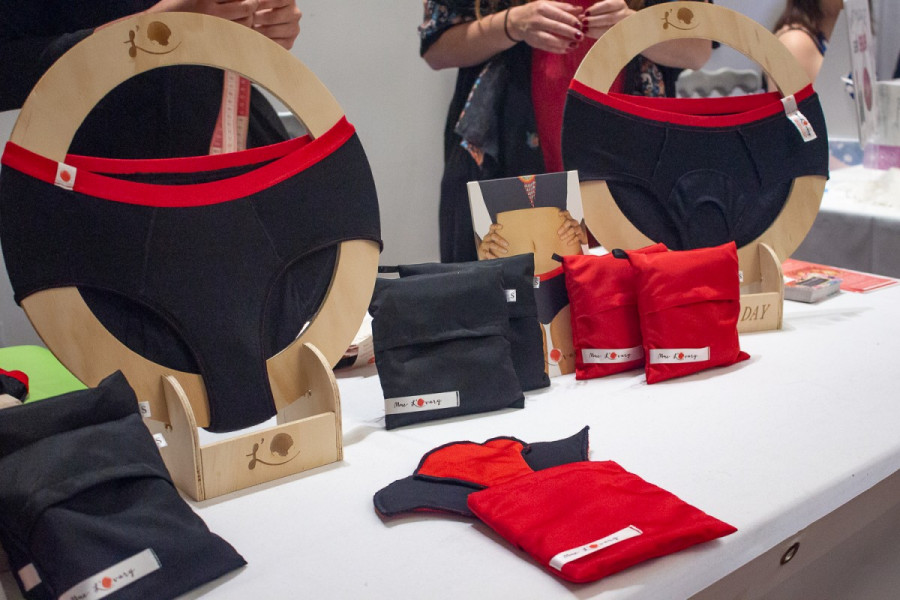
Heris explained that the night version features the pad inside of the panties, opposed to the daytime model that is detachable.
She mentioned that one of the benefits of the product is that its reusable and waste free.
“We’re very proud. It’s good for the earth, it’s good for our health, and it’s good to talk about [menstruation], because it’s still pretty […] taboo,” she said.
Heris thinks it’s a positive concept for future generations to learn about. In her opinion, many young girls are shy about talking about their periods, and can have an attitude of, “Oh why is this happening to me.”
“It’s a startup so we don’t have an infinite stock of underwear but eventually we’d love to have it in a few stores, or department stores like Simons,” said Heris.
Mme L’Ovary’s panties can be purchased online or at the store Terre à Soie, located on Ontario St. They also sell them at various festivals, like they were doing at Festivulve.
Heris views the period panties movement as being in a grey area between obscurity and mainstream popularity. Their design featuring the detachable pad is new in contrast to period panties that are absorbent popularized by the brand Thinx, that have been around for a few years.
“Thinx is […] different because you need to change the whole underwear. With us you just need to change the pad,” explained Heris.
“It’s underwear made for menstruation, that absorbs the blood. It’s zero waste and completely comfortable for the health of the vagina because its 100% cotton, there’s no synthetic material,” said Heris. She explained that the skin of the vulva is extremely delicate and sensitive when compared to the rest of the body, or even the face.
Clitoraid
Clitoraid is a private non-profit organization to help victims of female genital mutilation, and is staffed entirely by volunteers. Sylvie Elliot is one of those volunteers. She was tasked with tabling for the organization, as they tried to raise awareness and funds for an upcoming humanitarian mission in Kenya set to start on July 22nd.
“We’re here to help women who have been excised, (meaning the clitoris has been taken away) to restore the clitoris,” explained Elliot. The organization provides a free restorative operation for victims of female genital mutilation.
“We need to buy medical equipment for the operation. They follow up with the patients before, during and after the operation, there is also a psychological follow up after as well,” explained Elliot when asked about what they need funding for.
“Dr. Bowers is an American doctor and she works with us to help restore the clitoris, she operates on women who’ve had the excision.” Elliot explained that the doctor will be volunteering her time to teach three students how to perform the operation while in Kenya.
Like the people on the ground, all doctors associated with Clitoraid are volunteers.
According to Elliot, there are 40 women in Kenya who are waiting for Clitoraid to provide them with the surgery.Approximately 100 women have already had the operation, through Clitoraid.
“Clitoraid is a wonderful wonderful humanitarian organization,” expressed Elliot.
Tattoos par Sophie Potvin
Sophie Potvin is a local tattoo artist who was tabling at Festivulve on Sunday. There were a number of artists in attendance, but she was the only person there displaying artwork in the form of tattoos.
“There was a girl yesterday who was here tattooing, using the hand-poke method,” explained Potvin.
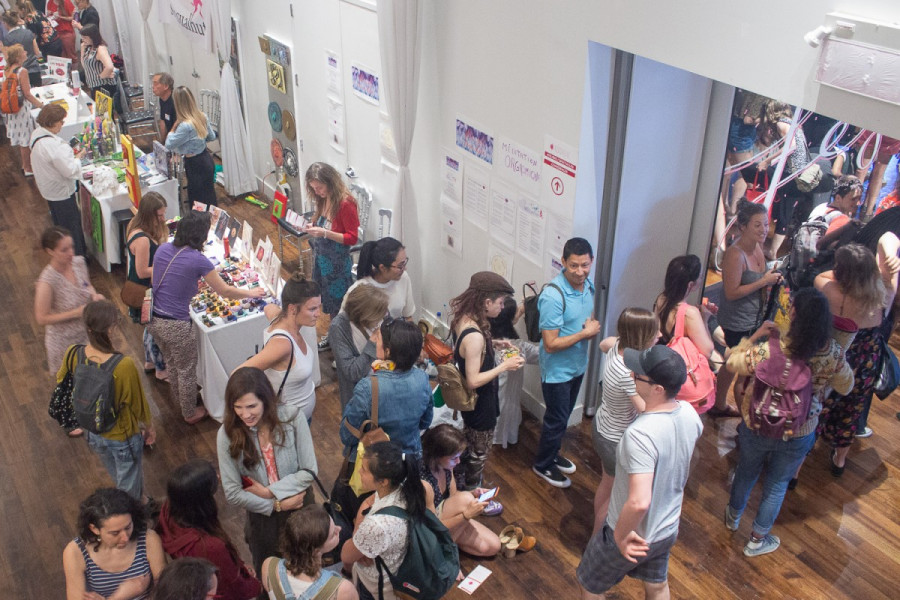
Potvin, covered in tattoos herself, had set up a small makeshift tattoo parlour tucked into a corner of the room where she tattooed festival-goers, using the traditional electric gun method. She had specifically designed a number of original themed pieces for the festival.
“I think this is a great festival and I’m glad someone took the initiative to start it,” said Potvin.
Potvin estimated that she’d already tattooed seven or eight people by around 2pm. She hopes to return to the festival for its fourth edition, where she also wants to tattoo people with henna.
Potvin viewed her participation at Festivulve to be a feminist act and said she attended Festivulve to support the cause. “We’re all in this together,” said Potvin.
By supporting the cause, she means the fight against the unrelenting stream of violence (mental and physical) that is perpetuated against the female sex.
“It’s a cause to honour the bodies of women, who are often humiliated and oppressed in this society. I think it’s important to celebrate the vulva, in all its different forms.”
She considers art to be an important part of activism, especially the art of tattooing because its a literal permanent message to the world that you’ve chosen to display on your body for the rest of your life.
//_For more information on the Festivulve, check out their website at https://www.festivulve.com_//

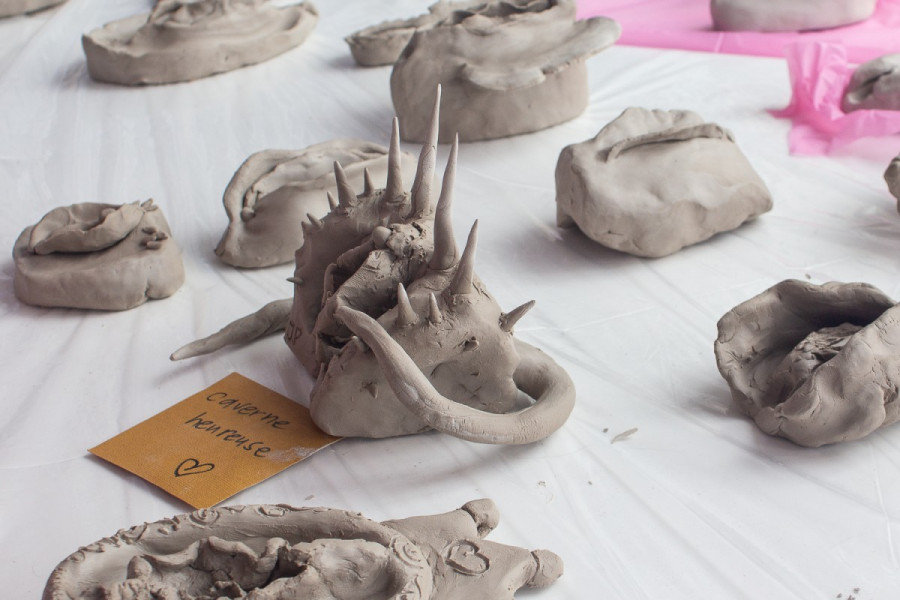
_600_832_s.png)

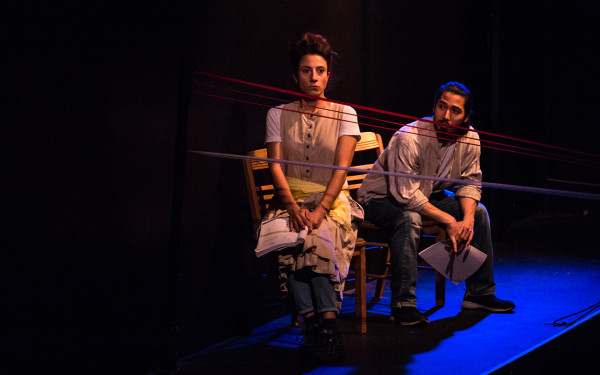
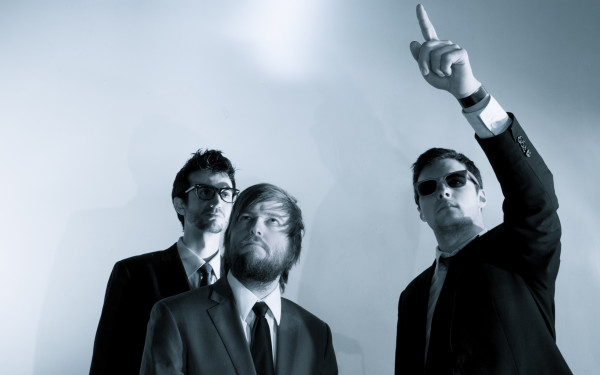

_600_375_90_s_c1.jpg)